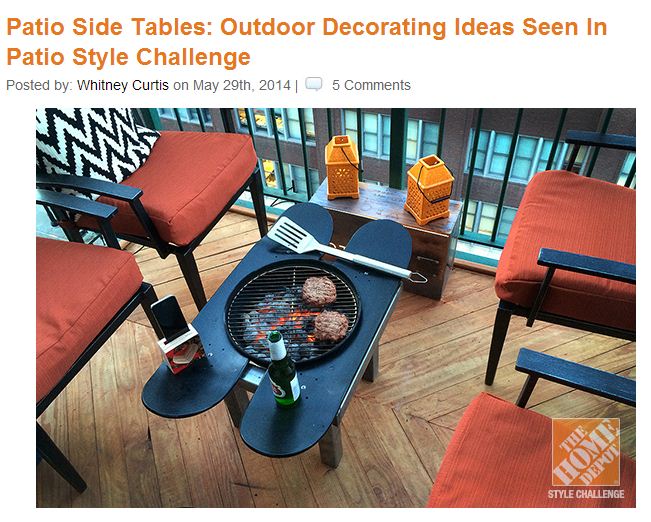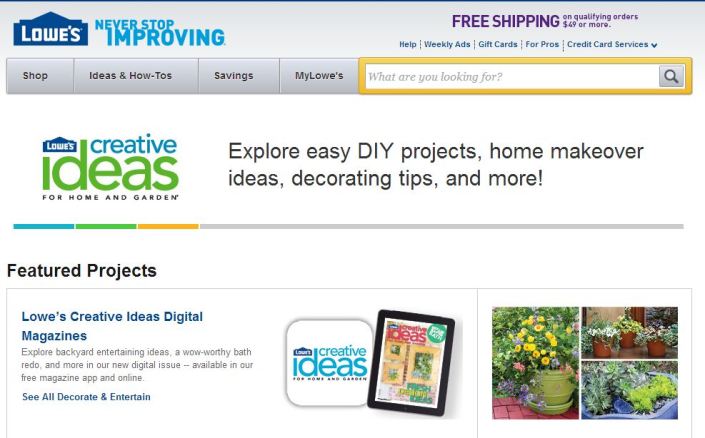Month: June 2014
Corporate DIY Blogs: A Dissection of Home Depot, Lowes, and True Value
Blogs have become an integral part of marketing. Can you name an advertising giant that doesn’t have some form of a blog? If you can, let me know! In this week’s post, I will be dissecting three blogs that interest me: The Apron (Home Depot), Creative Ideas (Lowes), and True Value Projects (True Value). Although these blogs share a relatively similar target audience, they each have specific components that make them interesting and different from their competitors.
The first blog that I chose to look at is The Apron by Home Depot. The Apron is a professional blog, maintained by Home Depot’s marketing team. The purpose of the blog is to inspire their DIY customer base to create projects, all with materials that are available at Home Depot. While many of these blog posts discuss creating projects around the home with new materials, some of them talk about reusing material, such as old skate boards or an old wheel barrel, to create new one of a kind decorative pieces for your backyard. Although I wouldn’t really consider myself a prime example of a person that Home Depot is trying to target, this blog inspires me to get in touch with my creative side.
One thing that is unique about The Apron in the hardware/DIY market is the large variety of project types that you find on the blog. One week you can read about making a leather tag for a bag and the next week, you could be learning how to build a fire pit out of old skateboards. Because the store has such a large variety of products, it makes sense for them to reflect a large variety of projects on their blog. Although the Home Depot has social media accounts that drive a lot of traffic to their blog, they do a poor job of advertising their social media pages on their blog. The social media icons that they have are very small and are seemingly lost at the bottom of the page. This is not only a wasted opportunity to drive social media engagement, but makes it more difficult for their audience to share these posts, which in turn makes the blog less successful. Even though advertisers are not directly on the site, the blog posts feature specific products that are “needed” in order to complete the project. Perhaps these specific name brand products are being sponsored by the brand. It was also very difficult to find The Apron from the Home Depot webpage.
Similar to The Apron, Lowes Creative Ideas blog is filled with DIY project information. This blog is also a professional blog, but due to the lack of dates on the posts, it is very hard to tell how frequently that last post occurred. The purpose of the blog is to inspire their audience to redecorate, redesign their yards, and improve their homes. One thing that differs on this blog from others in the DIY/hardware category is the amount of “soft” materials discussed on the blog. Soft materials are the more decorative items, such as bedspread, curtains, and lamps. Lowes carries more of this type of product in their stores and has a larger focus on interior design than most other DIY/hardware retailers. This is reflected on their blog. Lowes also does a good job at including DIY videos on their blog. This is another aspect that sets the Lowes blog apart from their competitors.
One major thing that I feel is missing from the Lowes blog is a corporate voice. There is very little personality to the posts in relation to their posts on social media. The human element seems to be missing. The social sharing buttons are also small and at the bottom of the page. The posts do, however, include the options to either Pin it on Pinterest or Like it on Facebook. I feel like more attention should be given to the social media elements in the pages. The site layout is not very “creative”. If the blog is called Creative Ideas and looks very plain, consumers may have a harder time feeling inspired. I know I wasn’t feeling like I wanted to go to Lowes and buy the materials to complete one of their DIY projects. Even though advertisers were not mentioned on the pages, in every post the item number of the materials used was given. Similar to Home Depot, the main traffic drivers to the Lowes blog was also through social media, specifically Pinterest and Facebook.
The third blog that I looked at in the DIY/hardware industry is True Value’s Project blog. Like the other two blogs that I’ve discussed in the industry, True Value’s blog is also a professional blog managed by their corporate marketing team. The thing that really sets the True Value blog apart from their competitor’s’ blogs is the visual nature of the blog. On the homepage, there is a large building with different areas being pointed out. When you click on the paintbrush, for example, you are redirected to a Father’s Day painting coaster project. With today being Father’s Day, I love how relevant this blog is to its audience. The layout of the blog is very easy to maneuver through and the social media icons are displayed much larger than on the competitor’s blogs. Social share buttons, including Facebook, Pinterest, and Twitter, are also present on each blog post.

True Value’s customers are typically more DIY focused than hardware focused. This is shown on their blog as the majority of their projects are DIY friendly. There are also not any advertisers present on the blog. There are not any featured products in the posts (like as seen on Home Depot’s blog) and product ordering numbers (like on Lowes blog) are also absent. In my opinion, True Value is doing an excellent job on educating their customers without the “buy this product” feature of the other two blogs. True Value also incorporates a strong SEO program into their blog. The blog shows up as #2 on Google when you search “hardware store blog”, although I didn’t see any evidence of PPC campaigns. Home Depot and Lowes don’t even show up on the first page. The only suggestion that I would make for the True Value blog is to increase their use of social media to continue to propel their content.
After dissecting the three blogs, I’m sure that you can tell which one, in my opinion, is the most effective at reaching out to customers (True Value!). I would love to see the actual analytics behind each blog and determine the types of posts that are really hitting home with their customers. Because these three blogs were very similar, small variations such as True Value’s idea house and Home Depot’s innovative up-cycling projects really made these blog stand out.
Integrated Marketing Campaigns and Push/Pull Strategies: Tory Burch, Part 2
In last week’s post, I discussed how Tory Burch utilizes multiple marketing channels as part of their integrated communications strategy. This week, I am going to further analyze the mediums and details that make Tory Burch’s integrated marketing campaign successful.
The first topic that I’m going to dive into is how Tory Burch utilizes push and pull techniques. Push marketing occurs when the brand initiates a conversation with the customer. One of Tory Burch’s main elements to their integrated marketing strategy is e-blasts. These targeted emails are sent out several times each week to people who have signed up for an account on ToryBurch.com. Available in several different languages and in several different countries, these emails direct customers back to their website and blog. The Tory Blog is also a way in which the company utilizes RSS feed to distribute product information to customers. With new posts every week, the Tory Blog is a content hub that is used to drive customers to make purchases on the company’s website.
In contrast with push marketing, pull marketing occurs when the customer initiates a conversation with the brand. One of Tory Burch’s major pull techniques involves social media. In an interview, Miki Racine, marketing executive for social media at Tory Burch, describes the relationships that occur on social media: “[Social Media] is a live focus group because we can listen to our customers in the moment” (Socha, 2013). Social media is important to Tory Burch’s Integrated Marketing Strategy because it gives customers a voice and a direct line to Tory Burch. Customers create the conversation. Remember when I talked about FitBit partnering with Tory Burch? Several customers are reaching out to Tory Burch on social media for more information (as it was supposed to launch this spring). Interestingly enough, Tory Burch has not responded to any of the comments regarding the FitBit. Wonder why? I’m curious as well. It’s also not a good sign if Tory Burch is choosing not to respond to these customer posts.
In last week’s post, I also spent a good amount of time discussing the Tory Blog as it relates to the company’s overall Integrated Marketing Strategy. The blog is actually integrated into the company’s website. In my opinion, the blog is a great example of how a corporate blog should be. There is catchy content, social media widgets that link back to the specific social media channels, fresh images, and is mobile friendly. The blog, as well as the website, was developed using a platform that allows it to be responsive based on the device that customers are using. The layout is clean and the messaging is consistent with all of Tory Burch’s imagery and messaging strategies. Fresh, unique content is also available on all of Tory Burch’s social media channels. Messaging is specific to the platform, but is part of the overall Integrated Marketing Strategy.

Tory Burch also includes SEO as an important part in their marketing strategy. They sponsor Google Ads as well as pay for ads on social media. Another important feature on all of Tory Burch’s sites is the social media links. Regardless if you are on the blog or on the website, you have all of the available social media links right at your fingertips.

One suggestion that I would make to Tory Burch in order to increase the visibility and branding of their website and blog is to be more strategic when naming images using the alt tag function. Tory Burch has a lot of great images on their website and blog, but these images are not being crawled by GoogleBots to the extent that they should be. For example, instead of naming the image “Shop Swim”, they could name the image “New Tory Burch Swim Wear & Bathing Suit Collection”. Although many marketers don’t often think about alt tags (and often just leave it up to IT to name the image), it is increasingly important to consider as part of your SEO and overall Integrated Marketing Strategy.
Overall, Tory Burch is doing a really good job at implementing their Integrated Marketing Strategy. By utilizing a combination of both push and pull marketing techniques, they are effectively reaching their audience and growing their business. I learned a few lessons from studying Tory Burch’s strategies and hope to be able to use this knowledge to further develop the Integrated Marketing Strategy for my company.
Sources:
Ramos, L. (2012, March 12). Kate Spade Vs Tory Burch. Retrieved June 08, 2014, from Web Lift: http://www.weblift.com/blog.php?id=kate-spade-vs-tory-burch
Socha, M. (2013, July 17). Tory Burch’s Miki Racine Berardelli Talks Social Media. Retrieved June 08, 2014, from Women’s Wear Daily: http://www.wwd.com/media-news/digital/tory-burchs-miki-racine-berardelli-talks-social-media-7056028?navSection=package&navId=7056764






















